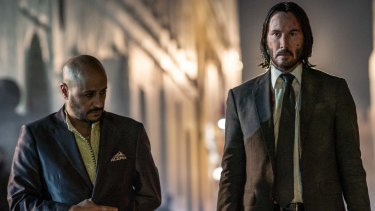Elegant Keanu Reeves goes the distance in John Wick: Chapter 3

JOHN WICK: CHAPTER 3 — PARABELLUM
MA, 130 minutes
★★★½
It all began with a puppy. A beagle named Daisy, to be precise, adopted by John Wick (Keanu Reeves), hitman extraordinaire, after his wife's death. When Daisy was killed by thugs, John became a dog let off the leash, embarking on a bloody rampage through the New York underworld which, two films later, has barely slowed down.
When we left him in John Wick: Chapter 2, John had broken a professional taboo by confronting a foe on the grounds of the Continental Hotel — the supposed epicentre of the New York assassination industry, where killings can be planned but not performed.
Thus in Parabellum, the third chapter of the series, director Chad Stahelski needn't waste much time on exposition before getting to the mayhem. Immediately, there's a multimillion-dollar bounty on John's head, with every desperado in the city anxious to collect.
Yassin (Aissam Bouali, left) and John Wick (Keanu Reeves) in John Wick: Chapter 3 – Parabellum.
As modern Hollywood action heroes go, John is something of an anomaly. He's an original creation, not directly borrowed from a TV show, comic book, or previous film series — and in just a few years he's acquired an unusually wide range of fans, including many who would no doubt be firm supporters of gun control in the real world.
In the past, I've had my doubts about how long his adventures should continue: can there be much left to say about a character and a universe so narrowly focused on slaughter? Still, it's impossible not to admire many ongoing aspects of the series: the poetry and showmanship, the audacious inverting of conventional morality and, of course, the flair of the stunts.
The main point is the surrealist elan, the way Stahelski and his team keep upping the ante on how much they can get away with: John dispatching one foe with a library book, tossing knife after knife into the body of another, or riding down the dark New York streets on horseback with a couple of motorcyclists in hot pursuit.
In its opening movement, Parabellum promises to be one long chase sequence that grows ever more hectic and dreamlike, like a gleaming nocturnal equivalent of Mad Max: Fury Road. Gradually, though, the clean lines of action get choked in the tendrils of the elaborate series mythology: assassins, in this universe, are like vampires – aristocratic beings who conduct their business behind the veil of what passes for reality to us ordinary folk.
Back for more are the survivors of the previous skirmishes, such as the honey-voiced Continental proprietor Winston (Ian McShane), and the imperious Bowery King (Laurence Fishburne). New faces include Anjelica Huston as the principal of a ballet school out of Dario Argento's Suspiria (“Art is pain, life is suffering”) and Asia Kate Dillon as a no-nonsense “adjudicator” with severely cropped hair and the vibe of an art school Mary Poppins.
Anjelica Huston in John Wick: Chapter 3 – Parabellum.
Truth be told, the hocus-pocus is laid on so thickly it no longer feels wholly tongue-in-cheek. There are points when the film could be taken for an occult allegory in the vein of Reeves' and Fishburne's earlier action franchise The Matrix (quoted directly at least once).
At the least, this is a story full of echoes of earlier stories, which are sometimes mysteriously suggestive, such as when John offers up a crucifix as a token that will ensure him safe passage, before uttering the magic word “Casablanca”.
Is there is anything of substance to hang on to amid these endless reflections? What is undeniable, certainly, is Reeves' dedication to his role, which suggests the enthusiasm of a puppy wanting to please.
While he performs many of his own stunts — as the film underlines through the use of wide shots — he isn't exactly a martial artist. Rather, he acts his way through his fight scenes, which supply most of the available insights into a character whose eloquence is physical rather than verbal.
The script might paint John as an invulnerable superhero, but Reeves shows us something different: a sharply dressed man near the end of his tether, who must summon all his resources to deal with each new threat.
Somehow, his flailing desperation adds to his elegance, as does his look of intense yet abstracted concentration: he dispatches his foes almost absent-mindedly, as if by muscle memory alone.
Source: Read Full Article

